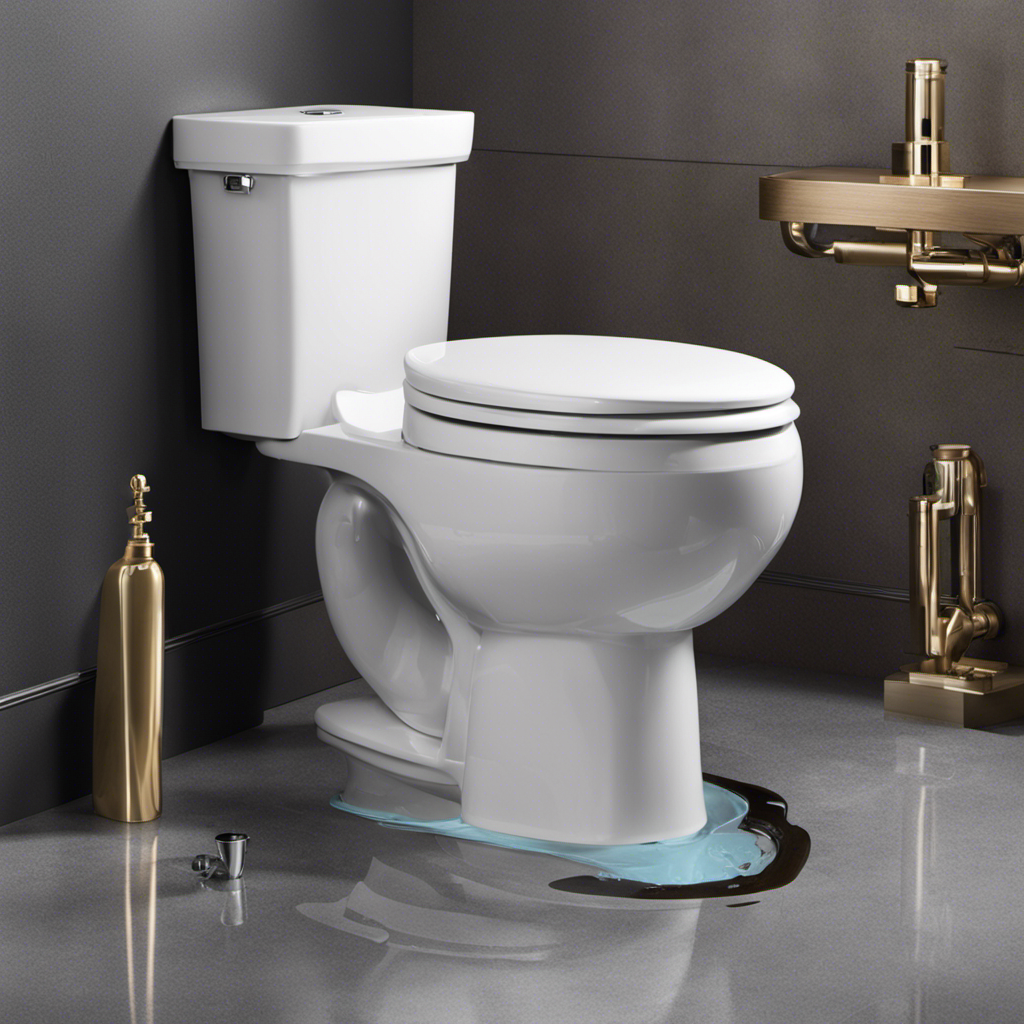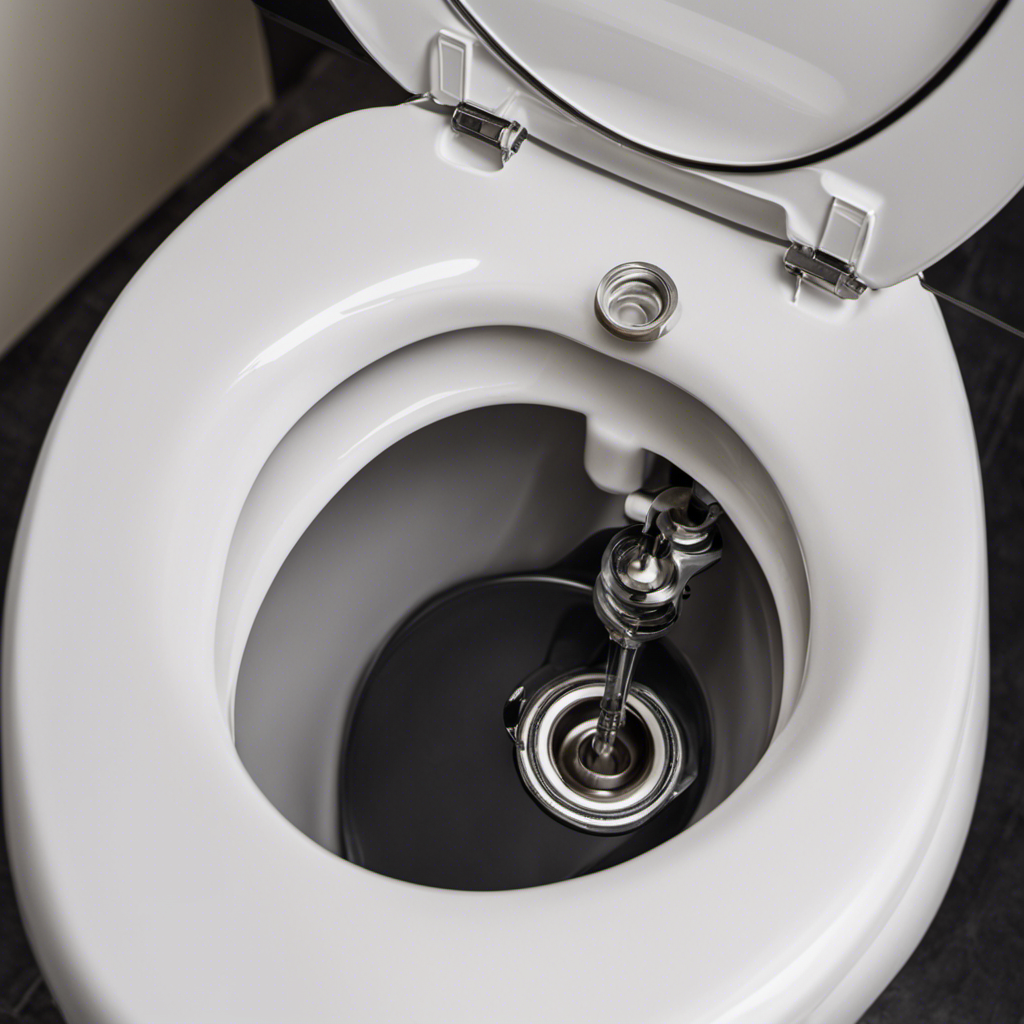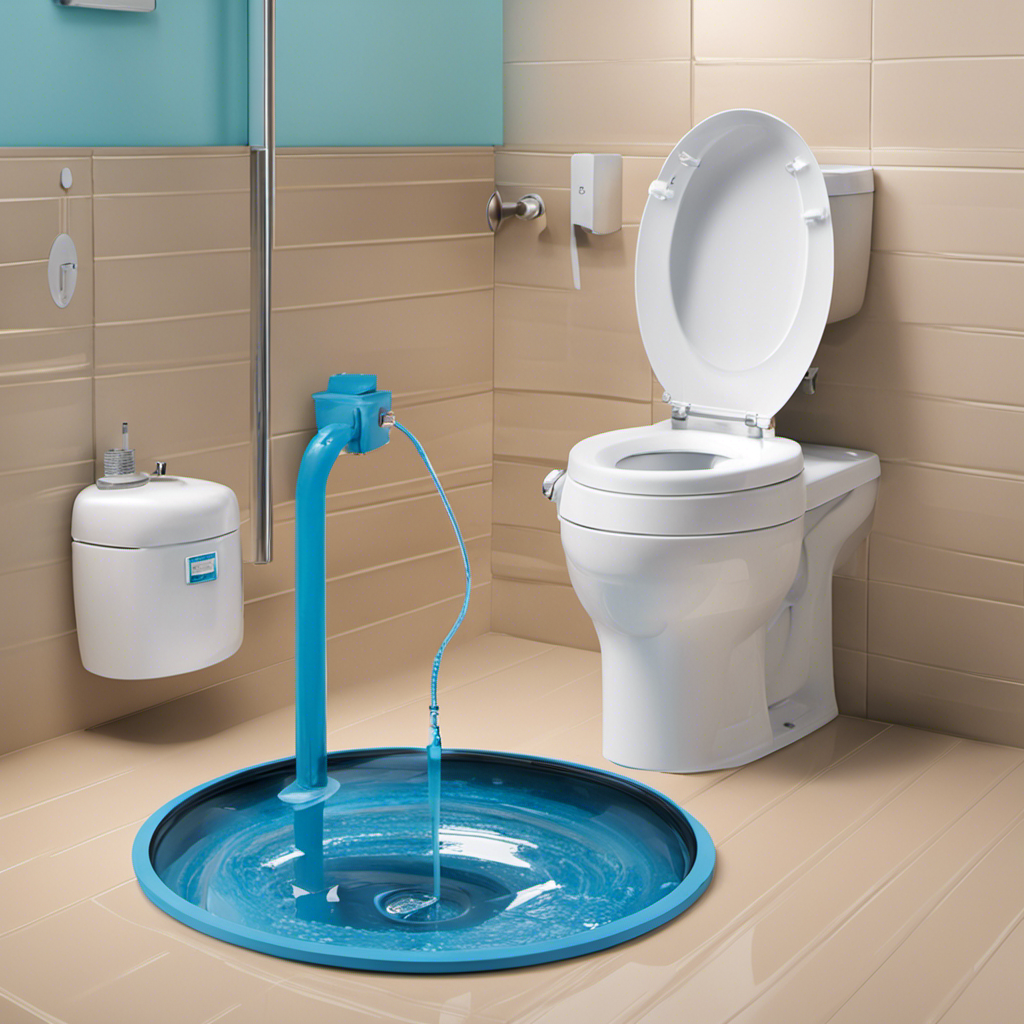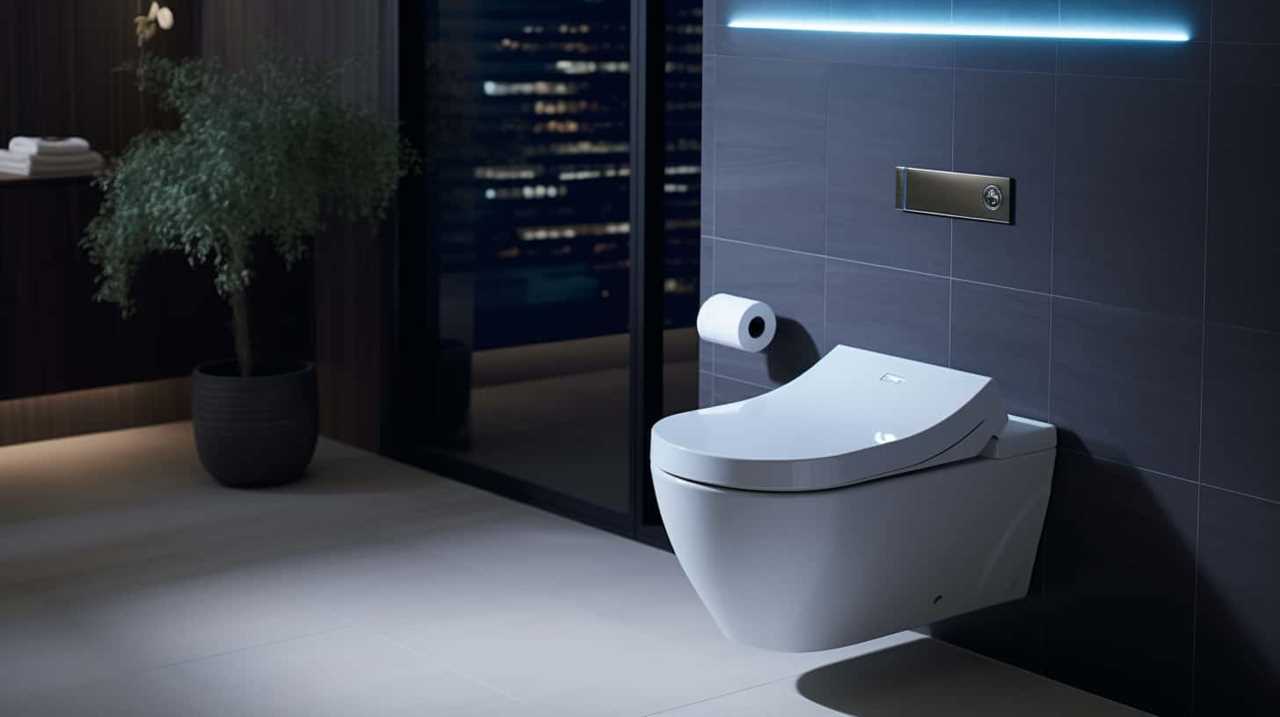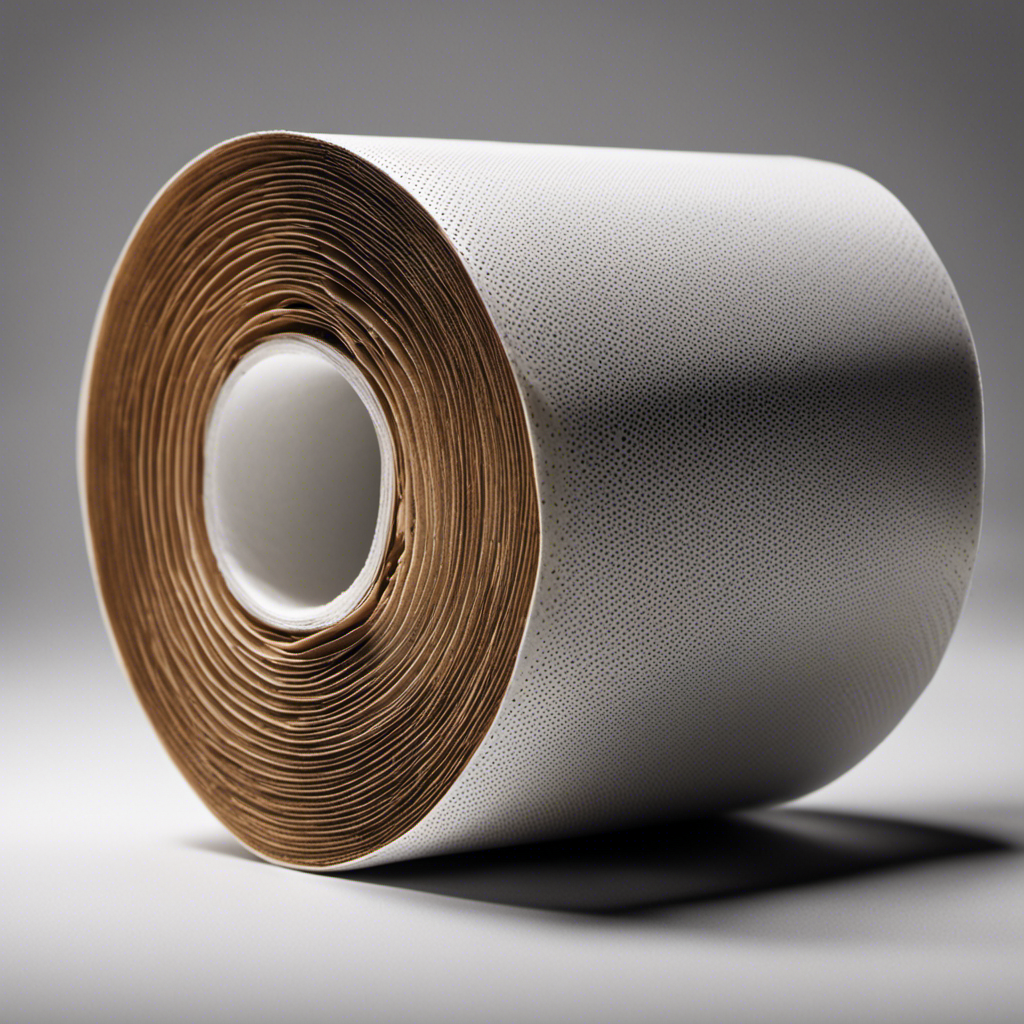Fixing a leaking toilet at the base may seem like a simple task, but the causes and solutions can be more complex than one might expect.
Surprisingly, a cracked toilet base, loose tee bolts, worn-out wax rings, water condensation, and improper mounting can all contribute to this frustrating issue.
However, fear not, as there are practical solutions for each of these problems. By replacing the cracked bowl, tightening the tee bolt nuts, installing new wax rings, addressing water condensation, and following proper installation steps, one can achieve a secure and leak-free toilet.
So, let’s dive into the world of toilet repairs and discover how to fix that troublesome leak at the base.
Key Takeaways
- Cracked toilet base, loose tee bolts, worn-out wax rings, and water condensation are common causes of toilet base leaks.
- Solutions for a cracked toilet base include removing and replacing the cracked bowl, using the same manufacturer’s model if available, and securing the new bowl with new screws and bolts.
- Loose tee bolts can be tightened by locating and tightening the nuts, ensuring the base is not easily movable, and being careful not to overtighten and break the bolts.
- Worn-out wax rings can be addressed by removing the old wax ring, cleaning the flange and toilet bowl surface, applying a new wax ring, and securing the bowl over the wax ring.
Cracked Toilet Base: Causes and Solutions
If a cracked toilet base is the cause of the leak, the best solution is to remove and replace the cracked bowl. Repairing a cracked toilet base is not recommended as it may not provide a long-term solution and could lead to further leaks.
Common signs of a cracked base include water pooling around the toilet, a loose or wobbly toilet, or visible cracks on the base.
To prevent toilet base leaks, regular inspection and maintenance are crucial. Homeowners should regularly check for any signs of cracks or damage and promptly address any issues. It is also important to properly maintain the toilet, including tightening tee bolts, replacing worn-out wax rings, and ensuring a watertight seal.
Loose Tee Bolts: Causes and Solutions
The loose tee bolts can be tightened by locating and tightening the nuts on the bolts. Here are some tightening methods and prevention measures to address this issue:
-
Tightening Methods:
-
Locate the nuts on the tee bolts and ensure they are securely tightened.
-
Use your hand to hold the bolt securely while turning the nuts.
-
Tighten the bolts by turning the threaded nuts clockwise.
-
Prevention Measures:
-
Ensure the base of the toilet is not easily movable.
-
Be careful not to overtighten and break the bolts.
-
Check for any plastic covers that may need tightening.
Worn-out Wax Rings: Causes and Solutions
One way to address worn-out wax rings is by removing the old wax ring with a putty knife before applying sealant and placing a new wax ring.
Replacing wax rings requires a step-by-step guide to ensure a proper seal and prevent leaks.
First, the old wax ring should be carefully scraped off using a putty knife. Then, the flange and toilet bowl surface should be thoroughly cleaned.
Next, a bead of sealant should be applied around the flange to provide additional sealing. The new wax ring is then placed on the flange, ensuring that it is centered and aligned with the bolt holes.
Finally, the toilet bowl is carefully lowered onto the wax ring, and the bolts are tightened to secure the toilet in place.
Following these steps will help to ensure a watertight seal and prevent future leaks.
Water Condensation: Causes and Solutions
Water condensation occurs when there is a temperature difference between the air and the surface of the toilet. It can be minimized by installing bathroom exhaust or ventilating fans.
To prevent water condensation and improve insulation techniques, consider the following:
-
Installing Bathroom Exhaust or Ventilating Fans
-
Allow heated air to escape and prevent condensation
-
Reduce the temperature difference between the air and toilet surface
-
Effective Insulation Techniques
-
Insulate the toilet tank more effectively
-
Minimize water condensation to prevent leaks
By installing bathroom exhaust or ventilating fans, you can ensure that heated air can escape, reducing the temperature difference between the air and toilet surface. This will help prevent water condensation.
Additionally, effective insulation techniques, such as insulating the toilet tank, can further minimize condensation and decrease the risk of leaks. By implementing these preventive measures, you can maintain a dry and leak-free toilet.
Toilet Installation Process: Step-by-Step Guide
To ensure a proper installation, it is important to carefully lift the toilet and align the holes on the base with the tee bolts. This step is crucial in creating a watertight seal and preventing leaks at the base. Common mistakes during toilet installation can lead to costly repairs and potential water damage.
Here are some toilet installation tips to avoid these mistakes:
- Use a level to ensure the toilet is properly aligned before securing it.
- Tighten the tee bolts evenly to prevent uneven pressure on the base.
- Do not overtighten the bolts as it may crack the toilet base.
- Use a new wax ring to ensure a proper seal and prevent leaks.
- Check for any loose washers or nuts and replace them if necessary.
Following these tips will help ensure a successful toilet installation and prevent any future issues.
Proper Bolt Tightening: Tips for a Secure Seal
With a secure grip on the bolt, the plumber tightens the nuts clockwise to ensure a proper seal. Proper bolt tightening techniques are crucial in preventing future leaks at the base of a toilet. Here are some tips for achieving a secure seal:
- Use your hand to hold the bolt securely while turning the nuts.
- Avoid applying excessive force to prevent damaging the toilet bowl.
- Tighten the bolts by turning the threaded nuts clockwise.
- Ensure the bolts are securely tightened to prevent leaks.
- Check for any loose washers or nuts and replace them if necessary.
By following these techniques, you can ensure that the toilet base is properly sealed, minimizing the risk of leaks and water damage.
Remember to regularly check the seal to maintain a leak-free toilet and address any issues promptly.
Troubleshooting Leaks: Common Issues and Fixes
Toilet base leaks can be a common and frustrating issue for homeowners. When faced with a leak at the base of the toilet, troubleshooting the problem is essential to prevent further damage.
There are several DIY repair tips that can help fix this issue. First, check the wax ring for any damage or wear. If necessary, replace the wax ring to create a proper seal.
Inspect the base of the toilet for cracks or gaps, and tighten the tee bolts if needed. If there are signs of leakage, further tightening of the bolts may be necessary. It’s also important to consider replacing the wax ring if it appears worn or damaged.
Importance of a Watertight Seal: Benefits and Maintenance
A watertight seal is crucial for preventing leaks and water damage. It not only keeps your bathroom clean and dry but also protects your home from potential structural issues caused by water infiltration. Here are some benefits of maintaining a watertight seal and some maintenance tips to ensure its effectiveness:
Benefits of a watertight seal:
- Prevents leaks and water damage.
- Keeps your bathroom clean and dry.
- Avoids costly repairs caused by water infiltration.
- Ensures the toilet remains stable and secure.
- Prevents foul odors from escaping.
Maintenance tips for a watertight seal:
- Regularly check the seal for any signs of wear or damage.
- Reapply sealant if necessary.
- Tighten the bolts if they become loose.
- Inspect the wax ring and replace it if worn or damaged.
- Seek professional help if unsure or uncomfortable with the installation process.
Seeking Professional Help: When to Call a Plumber
When experiencing uncertainty or discomfort during the toilet installation process, homeowners should consider seeking professional assistance from a plumber. Hiring professionals ensures that the installation is done correctly and reduces the risk of potential issues down the line.
While some homeowners may prefer to tackle the installation themselves, there are DIY alternatives available. However, it is essential to note that toilet installations can be complex, requiring technical knowledge and skills. Without proper expertise, DIY installations can result in leaks, unstable toilets, or even further damage.
Plumbers have the expertise to ensure a proper seal, saving homeowners time, effort, and potential costly repairs. When faced with a complex toilet installation or when unsure about the process, it is always wise to consult a professional plumber for assistance.
Frequently Asked Questions
Can I Use Any Wax Ring for My Toilet Installation?
Yes, any wax ring can be used for toilet installation. However, it is important to ensure proper alignment of the toilet and consider alternative sealants if a wax ring is not suitable.
How Do I Know if My Toilet Base Is Cracked?
To determine if a toilet base is cracked, look for signs such as visible cracks, water pooling around the base, or a wobbly toilet. These are indications that the toilet base may need repair.
What Can I Do if the Tee Bolts Are Too Tight and Won’t Loosen?
If the tee bolts on a toilet are too tight and won’t loosen, a person can use toilet installation tools like an adjustable wrench or pliers to carefully loosen the nuts. It’s important to avoid damaging the toilet bowl while doing so.
Can I Use a Sealant Other Than Wax Ring for the Toilet Installation?
Yes, an alternative sealant option to the wax ring for toilet installation is a rubber gasket. Rubber gaskets provide a watertight seal and have the advantage of being reusable. However, they may not be as effective in preventing leaks as wax rings.
How Do I Check if the Toilet Is Stable After Installation?
To check the stability of a toilet after installation, one can perform an inspection. This involves ensuring that the base is not easily movable and checking for any signs of leaks or cracks.
Conclusion
In conclusion, a leaking toilet at the base can be a frustrating and inconvenient problem. However, with the right knowledge and tools, it can be easily fixed.
Just like a leaky toilet, our lives may have cracks and loose ends that need attention. By taking the time to address these issues head-on, we can prevent further damage and create a watertight seal in our lives.
So, let’s tighten those bolts, replace worn-out parts, and seek professional help when needed. Together, we can ensure a smooth and leak-free journey.
